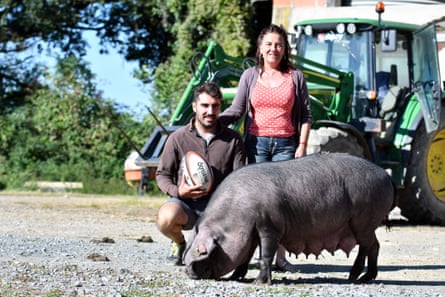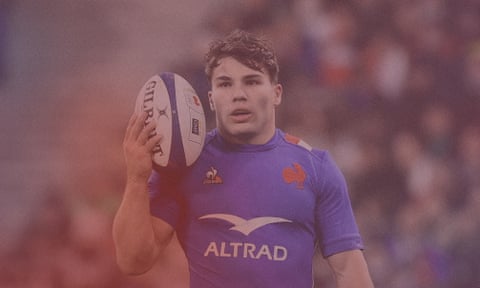The Hotel Dupont had been sitting empty for more than a decade. Situated at the heart of Castelnau-Magnoac, a village at the foothills of the Pyrenees, a 90-minute drive south of Toulouse, the establishment was owned and operated by Antoine Dupont’s family for several generations before being closed in 2012.
Looking to restore the restaurant to its former glory – its fame notably came from a distinctive duck magret recipe introduced in the 1970s – the local council renovated the building and re-opened it under a new name, La Taulada.
The emphatic signage on the building’s facade still bears the France star’s family name, though, and stands as an imposing reminder that this is the village that shaped Dupont, and vice versa. Although born in nearby Lannemezan, the Toulouse man would spend the entirety of his formative years in the hilltop Hautes-Pyrénées settlement before leaving for Auch at 15.
A decade on, Dupont is front and centre of France’s shot at World Cup glory on home soil. The mercurial scrum-half’s unrivalled influence on games led to him being named World Player of the Year in 2021, and he was a cover star for GQ France the following January. Later that year he led his country to a first Six Nations title in more than a decade.

Les Bleus’ No 9 is unmistakably the face of the tournament – his image is ubiquitous in advertising campaigns across the country and is plastered in every host city. Notably, he recently starred in a Volvic advert which was inspired by the brand’s campaign back in 2000 with Zinedine Zidane. While the three-time French champion does not have the midfield legend’s lasting prominence on the national stage yet, a home World Cup win of his own would undoubtedly boost his profile to similar levels.
During his rise to the top, Dupont has sought to make sure his link with his home would remain as strong as ever. Alongside his older brother, Clément, the scrum-half invested last year in renovating the Domaine de Barthas grounds and restaurant just outside the village, where the two spent the bulk of their childhoods.
The three-time Top 14 winner is a regular face at the Stade Jean-Morère for the club’s end-of-season finals, and also comes back whenever he can to see friends and family. For Gaëtan Rousse – a cousin of Dupont’s, who also plays at scrum-half for Castelnau – the France international has not been changed by fame: “We don’t necessarily realise that we have a cousin or a friend who’s the best player in the world.”

Rousse says that Dupont’s stays in Castelnau offer him a much-needed break from the spotlight, having now become a household name in France, beyond rugby circles. “I think that’s why he enjoys coming back, he knows that he’ll be seeing the people he knows, he won’t necessarily have all the attention on him like in the city.”
The president of FC Magnoac, Sébastien Bousquet, recalls that Castelnau’s most famous son started playing rugby “as soon as he could walk”, and joined the local area’s rugby school once he was eligible for a federation licence. He would hone his talent playing at the stadium with his brother, cousins and friends whenever the senior team had vacated the pitch. Playing against older boys would pay dividends for the young Dupont – to the point that there were youth competitions in which he was barred from scoring tries.
Bousquet explains that the club’s recent rapid rise up the divisions – four promotions in four years – has been down to a concerted effort to bring back locals who had gone on to play at a higher level. Over time, cousins and childhood friends of Dupont have come back one by one, bringing with them several players from their former clubs. “We’re just missing Antoine now – we’ll give him a year or two, but after that he needs to come back!”
Before the start of high school, Dupont made the journey an hour north into the Gers department, to join the Auscitain training set‑up. The former first-tier regulars play at the Stade Jacques‑Fouroux – named after the Auch native scrum‑half who captained France to the 1977 grand slam, before repeating the feat as manager in 1981 and 1987. After its previous iteration was liquidated in 2017, the club has had to climb up the divisions again, and now plays in the fourth‑tier National 2.

Despite falling on hard times, the club’s reputation as a breeding ground for international level talent is now as strong as ever. Four members of France’s squad for the World Cup came through the Auch system, all at the same time: Dupont, Anthony Jelonch, Grégory Alldritt, and Pierre Bourgarit. More recently, the club’s U18 team won their national championship last year and were promoted to the junior-level top flight, the René Crabos cup.
Siegfried Vandekerkof, a winger who also manages the club’s training ground and youth development, underlines the depth of the south-west’s talent pool. Keeping the region’s young talent away from the limelight, at least during their formative years, he says, is a cornerstone to Auch’s success. “We have players who went under the radar to start with, like Antoine due to his height, and that allows us to keep them, to shelter them a bit,” says Vandekerkof.
The collective knowhow when it comes to tapping into the surrounding area’s wealth of talent has been key in getting the club back on track. “We look to work within our means as much as possible so that they reach the highest level. We’re not a rich club, we can’t go and sign players from elsewhere, so 80% of our squad was brought up in the Gers.”
Vandekerkof also points to a “legacy” of consistently producing top players that the club’s custodians need to live up to, despite their amateur status. A comprehensive programme involving daily training sessions looks to achieve that, and has recently begun attracting players from across the country.
after newsletter promotion
The club’s president, Bernard Salam, points out that training and giving chances to young players has always been the bedrock of Auch’s approach, no matter the division. He goes as far as saying that the club would simply not survive without its youth training set-up – banking on their nationwide reputation in that regard is more important than ever given their recent financial troubles.

Salam, a former player and coach at Auch and now in his second stint as president, speaks of the team and the town’s “great pride” at seeing its four former players reach the very top. He also hopes that the exposure the internationals are giving the club will help bring in new sponsors in the future, as he looks to secure long-term stability. For now, a return to the Pro D2 is a distant prospect – not least given the team’s best talents are consistently poached by professional clubs.
Kévin Ribreau is one of those who witnessed Dupont’s growth first-hand all the way, and was the coach when Auch reached the final of the Crabos cup in 2014, with Jelonch also in the team.
As technical adviser at the department’s training facilities, he also coached the pair in separate, specialised weekly training sessions. “They took an unusual path,” he says – usually, elite emerging prospects are selected to join the national training centres, and are eventually drafted in by Top 14 academies. Instead, the “reserved and shy” Dupont stayed at Auch, a club which, for Ribreau, stands out for its “family values” and serves as a perfect stepping stone for “village lads” like him – “I think it was the ideal environment for them.”
Although they would end up losing to Racing 92 in 2014, Ribreau recalls that campaign as the one which saw the 18-year-old Dupont “explode”, having scored in every round of the tournament. By that time, the buzz around Dupont had spilled over well beyond the Gers borders. He would move to Castres the following summer, and soon joined the national youth teams.
A focus on development and local identity has been key in getting both RC Auch and FC Castelnau back on their feet. The south-west of the country has always been the beating heart of French rugby – and the impressive work being carried out by its clubs in challenging circumstances are ensuring it will continue to be so long into the future.
Castelnau-Magnoac’s “Dupont museum” consists of a collection of shirts from his previous clubs, as well as mementoes and pictures charting the scrum-half’s career – from childhood tournaments to collective and individual trophies.
There’s a conspicuous blank space on the bottom right of the display, though. When they gather in the rugby team’s clubhouse on Friday night for the World Cup opener, the locals will be watching their player known as “Toto” begin his quest to fill it in with the one trophy that still eludes him.
Raphaël Jucobin is a French rugby and football writer
